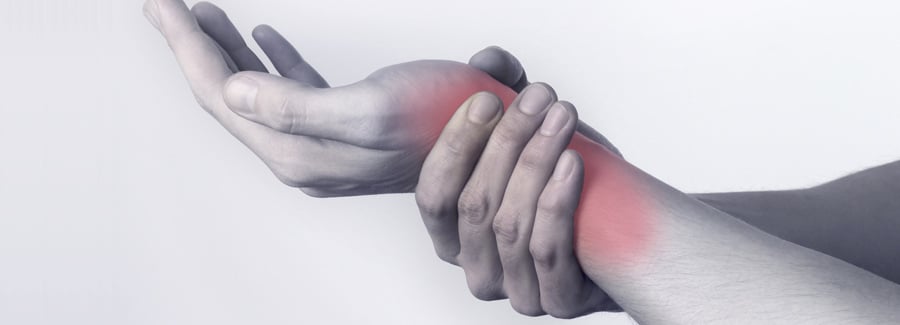
Upper Extremity Fractures
It is not uncommon for patients to present at Focus Physiotherapy for upper extremity fractures following a serious car accident. Our team has the experience to address your fracture and coordinate your recovery.
We understand that serious injuries not only affect a person’s function, but their liveliehood as well. We will coordinate your recovery while communicating the extent of your injuries to the appropriate companies and insurers.
Your recovery from an upper extremity fracture is in good hands with our team. Our common sense approach uses best practices and is focused on helping you reconver and return to your daily activities.
Clavicular (collarbone) fracture
Clavicular (collarbone) fracture usually is a result of a fall or direct force onto the arm or shoulder. It can occur in all age groups. The most common treatment is a sling and swathe. As the bone is healing a large “bump” may develop as part of the healing process. This usually disappears, although a small bump may remain.
A Scapular fracture
A Scapular fracture is rare, although it is seen in trauma patients as a result of high-energy blunt trauma, such as motor vehicle crash, motorcycle crash or a fall. A sling is a usual treatment; however, this injury may require surgery. It is important to check with your doctor regarding moving your shoulder, as it may take six months to a year to get complete motion back in the shoulder. Because the injury is the result of a high-energy trauma, other fractures usually accompany this injury.
Shoulder (glenoid, humeral head or humeral neck) fracture
Shoulder (glenoid, humeral head or humeral neck) fracture usually is a result of a fall onto an outstretched arm or from direct trauma to the shoulder. Focus Physiotherapy can help you recover from your fracture.
Humerus (upper arm) fracture
Humerus (upper arm) fracture usually is the result of a direct blow on the upper arm, a fall onto the arm or a motor vehicle crash. Depending on your age, the treatment may be a cast, a sling or surgery. Our Registered Physiotherapists can assist you on the road to recovery following such injuries.

Olecranon (elbow) fracture
Olecranon (elbow) fracture usually is the result of a direct blow or fall onto the point of the elbow. There are different types of “elbow” fractures, so ask your doctor about your type. The most common initial treatment for this fracture is surgery followed by an extensive regimen of physiotherapy.
Radius or ulna (lower arm) fracture
Radius and ulna (lower arm) fracture usually is the result of a fall onto your extended arm or a direct blow to your lower arm. Fracturing one or both bones in your lower arm is possible. The treatment depends on the severity of the fracture, which bone is fractured and where the fracture is. Treatments for this type of fracture include a cast or surgery followed by physiotherapy.

Scaphoid (wrist) fracture
Scaphoid (wrist) fracture is a fracture that is located on the thumb side of your wrist. It usually is the result of a fall onto an outstretched wrist or a motor vehicle crash. The treatment of this fracture may begin with a cast. If the bone isn’t healing, surgery may be necessary. This fracture typically takes some time to heal.
A Physiotherapy assessment is always the right way to ensure the fullest recovery possible. Any Fracture, when left untreated, may never fully recover, and the underlying functional losses significantly reduce the quality of life.
Focus Physiotherapy will direct your recovery to ensure you reach maximum medical recovery.
Following surgery, our team will assist you in recovering the range and strength lost from prolonged immobilization and will also help you in returning to normal daily activities.
Our Treatment For Upper Extremity Fractures
Common sense and patient-centered care dictate our choice of interventions and treatment. Our thorough assessment of your injury and needs will form the blueprint for your recovery road map. We will work closely with you, and if you wish, your family, employer and other health care team members to address what you feel is important.
Your treatment can consist of many possible services we offer, and we may even request further diagnostic testing if we feel something may have been missed at another facility. Overall you should feel confident in the knowledge that your recovery from the fracture is in good hands, and you should expect to play a significant role in the recovery process.
After six weeks the severe pain goes away, but the toe is still too swollen to fit in shoes. The severe pain is replaced by aches and stiffness that increases with activity. The pain is not severe, but is definitely an annoyance that will make you want to limit your walking. The toe will remain swollen for a year, with the pain becoming less and less over time. However, even at a year the toe will occasionally swell and ache with weather changes. You can probably now imagine how things are with larger bones.
Mississauga: 416-961-2001
Brampton: 416-961-2001
Etobicoke Kingsway: 416-961-2001
Bolton: 416-961-2001
North York: 416-961-2001
York: 416-961-2001
The road to recovery starts with one step, and that step starts with contacting us at Focus Physiotherapy.
